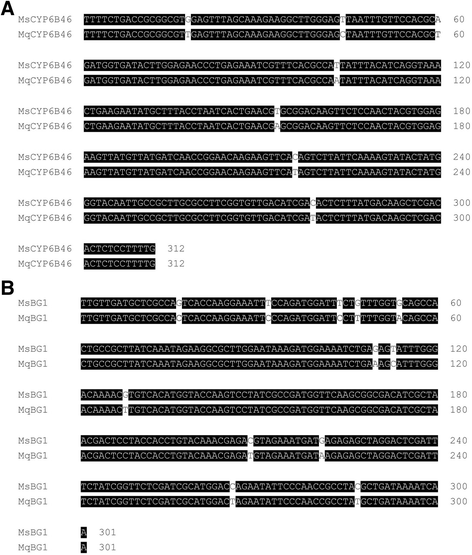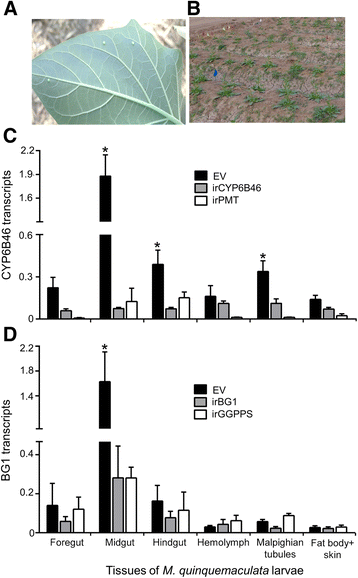Plant-mediated RNAi silences midgut-expressed genes in congeneric lepidopteran insects in nature
- PMID: 29132300
- PMCID: PMC5683459
- DOI: 10.1186/s12870-017-1149-5
Plant-mediated RNAi silences midgut-expressed genes in congeneric lepidopteran insects in nature
Abstract
Background: Plant-mediated RNAi (PMRi) silencing of insect genes has enormous potential for crop protection, but whether it works robustly under field conditions, particularly with lepidopteran pests, remains controversial. Wild tobacco Nicotiana attenuata and cultivated tobacco (N. tabacum) (Solanaceae) is attacked by two closely related specialist herbivores Manduca sexta and M. quinquemaculata (Lepidoptera, Sphingidae). When M. sexta larvae attack transgenic N. attenuata plants expressing double-stranded RNA(dsRNA) targeting M. sexta's midgut-expressed genes, the nicotine-ingestion induced cytochrome P450 monooxygenase (invert repeat (ir)CYP6B46-plants) and the lyciumoside-IV-ingestion induced β-glucosidase1 (irBG1-plants), these larval genes which are important for the larvae's response to ingested host toxins, are strongly silenced.
Results: Here we show that the PMRi procedure also silences the homologous genes in native M. quinquemaculata larvae feeding on irCYP6B46 and irBG1-transgenic N. attenuata plants in nature. The PMRi lines shared 98 and 96% sequence similarity with M. quinquemaculata homologous coding sequences, and CYP6B46 and BG1 transcripts were reduced by ca. 90 and 80%, without reducing the transcripts of the larvae's most similar, potential off-target genes.
Conclusions: We conclude that the PMRi procedure can robustly and specifically silence genes in native congeneric insects that share sufficient sequence similarity and with the careful selection of targets, might protect crops from attack by congeneric-groups of insect pests.
Keywords: CYP6B46; Manduca quinquemaculata; Plant-mediated RNAi; RNA interference; Transgenic tobacco plants; β-glucosidase.
Conflict of interest statement
Ethics approval and consent to participate
Not applicable
Consent for publication
Not applicable
Competing interests
The authors declare that they have no competing interests.
Publisher’s Note
Springer Nature remains neutral with regard to jurisdictional claims in published maps and institutional affiliations.
Figures




Similar articles
-
Tobacco rattle virus vector: A rapid and transient means of silencing manduca sexta genes by plant mediated RNA interference.PLoS One. 2012;7(2):e31347. doi: 10.1371/journal.pone.0031347. Epub 2012 Feb 1. PLoS One. 2012. PMID: 22312445 Free PMC article.
-
Molecular interactions between the specialist herbivore Manduca sexta (lepidoptera, sphingidae) and its natural host Nicotiana attenuata. VI. Microarray analysis reveals that most herbivore-specific transcriptional changes are mediated by fatty acid-amino acid conjugates.Plant Physiol. 2003 Apr;131(4):1894-902. doi: 10.1104/pp.102.018184. Plant Physiol. 2003. PMID: 12692348 Free PMC article.
-
Tobacco plants expressing the Cry1AbMod toxin suppress tolerance to Cry1Ab toxin of Manduca sexta cadherin-silenced larvae.Insect Biochem Mol Biol. 2011 Jul;41(7):513-9. doi: 10.1016/j.ibmb.2011.04.013. Epub 2011 May 23. Insect Biochem Mol Biol. 2011. PMID: 21621616
-
Improved insect-proofing: expressing double-stranded RNA in chloroplasts.Pest Manag Sci. 2018 Aug;74(8):1751-1758. doi: 10.1002/ps.4870. Epub 2018 Mar 7. Pest Manag Sci. 2018. PMID: 29377554 Free PMC article. Review.
-
RNA-based technologies for insect control in plant production.Biotechnol Adv. 2020 Mar-Apr;39:107463. doi: 10.1016/j.biotechadv.2019.107463. Epub 2019 Oct 31. Biotechnol Adv. 2020. PMID: 31678220 Review.
Cited by
-
Expression and functional analysis of P450 gene induced tolerance/resistance to lambda-cyhalothrin in quercetin fed larvae of beet armyworm Spodoptera exigua (Hübner).Saudi J Biol Sci. 2020 Jan;27(1):77-87. doi: 10.1016/j.sjbs.2019.05.005. Epub 2019 May 22. Saudi J Biol Sci. 2020. PMID: 31889821 Free PMC article.
-
Application progress of plant-mediated RNAi in pest control.Front Bioeng Biotechnol. 2022 Aug 8;10:963026. doi: 10.3389/fbioe.2022.963026. eCollection 2022. Front Bioeng Biotechnol. 2022. PMID: 36003536 Free PMC article. Review.
-
Transgenic expression of mAChR-C dsRNA in maize confers efficient locust control.Plant Commun. 2025 May 12;6(5):101316. doi: 10.1016/j.xplc.2025.101316. Epub 2025 Mar 15. Plant Commun. 2025. PMID: 40091346 Free PMC article.
-
Providence virus: An animal virus that replicates in plants or a plant virus that infects and replicates in animal cells?PLoS One. 2019 Jun 4;14(6):e0217494. doi: 10.1371/journal.pone.0217494. eCollection 2019. PLoS One. 2019. PMID: 31163039 Free PMC article.
-
Nano-delivery platform with strong protection and efficient delivery: preparation of self-assembled RNA pesticide with dual RNAi targets against Apolygus lucorum.J Nanobiotechnology. 2025 Feb 7;23(1):93. doi: 10.1186/s12951-025-03155-x. J Nanobiotechnology. 2025. PMID: 39920702 Free PMC article.
References
-
- Terenius O, Papanicolaou A, Garbutt JS, Eleftherianos I, Huvenne H, Kanginakudru S, Albrechtsen M, An C, Aymeric JL, Barthel A, et al. RNA interference in Lepidoptera: an overview of successful and unsuccessful studies and implications for experimental design. J Insect Physiol. 2011;57(2):231–245. doi: 10.1016/j.jinsphys.2010.11.006. - DOI - PubMed
-
- Liuqi G, Douglas CK. Recent advances in RNA interference research in insects: Implications for future insect pest management strategies. Crop Prot. 2013;45:36–40.
MeSH terms
Substances
LinkOut - more resources
Full Text Sources
Other Literature Sources

